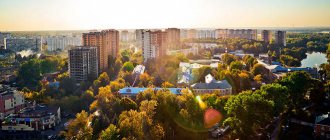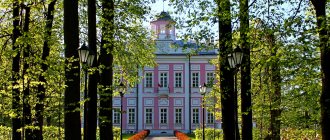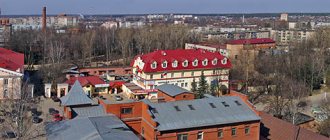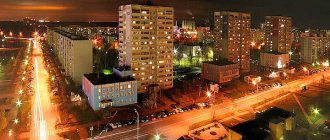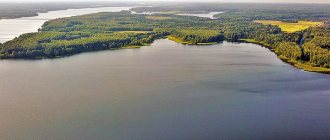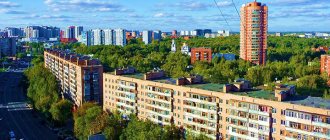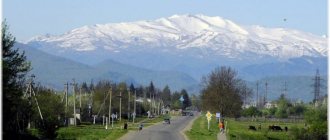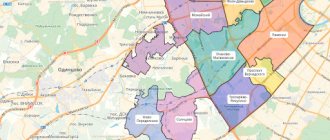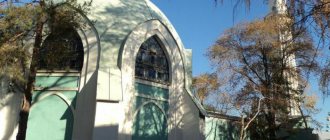Known since the 16th century. First as the village of Safatovo, in 1589 it was renamed the village of Voskresenskoye after the Church of the Resurrection of the Lord. In 1656, Voskresenskoye and three adjacent villages (Makrushino, Sychovo, Redkino) were bought by Patriarch Nikon from the steward Roman Boborykin. The village was transformed into the district town of Voskresensk in 1781. Since 1796 it has been a provincial town.
In the “List of Populated Places” of 1862 - a provincial town of the 2nd camp of the Zvenigorod district of the Moscow province on the Istra River, 726 versts from St. Petersburg and 50½ versts from the provincial city, with 121 houses and 2784 inhabitants (1467 men, 1317 women) . In the city there was a monastery (Resurrection New Jerusalem Monastery), an Orthodox church, a postal station, two factories and a fair. Throughout the 19th century, Voskresensk remained one of the smallest cities in the Moscow province: its population did not exceed 3 thousand people.
“Projected” plan of the city of Voskresensk in 1784 from the “Complete Collection of Laws of the Russian Empire. Book of drawings and drawings. City plans"
According to the materials of the All-Union Population Census of 1926, the center of the Voskresensky district of the Moscow province, 3281 inhabitants (1498 men, 1783 women), the city had a district executive committee, a Luchinsky volost executive committee, there was a hospital, a dispensary, a veterinary hospital, an agricultural center, a silk-winding factory and a steam flour mill.
In 1930, the city was renamed Istra after the river flowing through it. As a result of a short occupation during the Great Patriotic War from November 26 to December 10, 1941, Istra was severely destroyed.
The project for the restoration of the city (published in 1946) was developed by academician Alexei Shchusev, who visited Istra to survey the destruction of the New Jerusalem Monastery. According to the architect's plan, Istra was to become a health resort near Moscow. The project took into account the natural features of the city’s surroundings and its historical past. Some city buildings designed by Shchusev were supposed to resemble structures of Russian architecture of the 17th century. In the central square, it was planned to erect buildings made of red brick with white trim and window frames decorated with majolica, similar to the ceramic decorations of the New Jerusalem Monastery. The residential building was supposed to be low-rise wooden, repeating the shape of a Russian hut, on lightweight frame structures with partial use of preserved old foundations. On the right bank of the Istra River it was planned to build sports facilities with a reservoir. It was planned to remove the Volokolamsk Highway from the city limits. However, the project was not implemented; according to Shchusev’s plan, only a few houses were built on Kooperativnaya Street.
The economic development of the city in the second half of the 20th century was associated first with the location of an enterprise for the production of equipment for coal mining (experimental), and then with the opening of branches of Moscow research institutes of the electrical industry.
In 2015, by resolution of the Moscow Regional Duma, the city was awarded the honorary title “Settlement of Military Valor.”
Brief description of Istra
Istra is a city of military valor and the center of the Istra urban district in the Moscow region. The population is just over 34 thousand people, and the area of the city is 7 km2. Istra is located 40 km west of Moscow.
Istra is located in the near Moscow region
Istra has sister cities:
- Bad Orb (Germany);
- Rakovnik (Czech Republic);
- Dyurtyuli (Russia);
- Pinsk (Belarus;)
- Petrich (Bulgaria);
- Loreto (Italy);
- Lobez (Poland);
- Becej (Serbia).
Brief history of the city
The history of the city began in the 16th century. True, at first it was the small village of Safatovo, which in 1589 was renamed Voskresenskoye. About 70 years later, the village was bought by Patriarch Nikon. Together with Voskresensky, the deed of sale included the villages of Sychovo, Makrushino and Redkino. The territory was expanded, so the district town of Voskresensk was created from the village (1781). Since 1862, Voskresensk was a provincial town in the Zvenigorod district of the Moscow province with a population of more than 3,000 people.
Voskresensk was renamed Istra in 1930. In November-December 1941, Istra was occupied by the Germans and severely destroyed. After the war, architect Alexey Shusev took up the task of restoring Istra. In addition, industrial development began. Currently, tourism activities are actively developing in the city.
Modern Istra was rebuilt from ruins left during the Great Patriotic War
Population
| Population | ||||||
| 1931[10] | 1939[11] | 1970[12] | 1979[13] | 1989[14] | 2002[15] | 2006[16] |
| 62 434 | ↗80 366 | ↗84 677 | ↗88 000 | ↗90 572 | ↗115 753 | ↘112 973 |
| 2009[17] | 2010[18] | 2011[19] | 2012[20] | 2013[21] | 2014[22] | 2015[23] |
| ↗113 960 | ↗119 641 | ↗119 960 | →119 960 | ↘119 882 | ↗120 619 | ↗120 703 |
| 2016[24] | 2017[4] | |||||
| ↘120 526 | ↗121 363 | |||||
How to get to Istra
It is convenient to get to Istra from Moscow:
- by bus from the metro stations “Myakinino” (No. 580), “Tushino” (No. 372);
- by train or train from Rizhsky station (Istra, Volokolamsk, Shakhovskaya) or with a transfer through Dedovsk;
- by car along Volokolamsk or Novorizhskoe highway.
From Moscow to Istra along the Volokolamsk highway it will take 72.6 km, and the road through Dedovsk will be 59.3 km
Tesla coil
This is the popular name for the high-voltage test coils built in the forests near Istra by the All-Russian Electrotechnical Institute. Scientists have studied the effects of super-powerful electromagnetic pulses. Local residents say that an anomalous lightning strike 150 meters long was recorded here. Not everyone manages to get to the facility - it is classified as protected. However, some curious tourists manage to make their way to the semi-abandoned site. A landmark for adventure seekers is Zavodskaya Street, 5.
Sightseeing overview
The most beautiful places in Istria can be divided into the following groups of attractions:
- architectural;
- cultural;
- historical;
- natural.
Architectural monuments, historical sites and cultural attractions of Istria
The main cultural attractions of the city are represented by individual buildings, architectural complexes and estates. Like all ancient Russian cities, Istra has many monuments of a religious nature, as well as those related to the Great Patriotic War and the October Revolution.
Architectural and Ethnographic Museum of Wooden Architecture
The Architectural and Ethnographic Museum of Wooden Architecture was created in the second half of the 20th century. Wooden objects from different areas of the Moscow region were transported here:
- estate of the Kokorin family (XIX century);
- chapel (XVIII century);
- windmill (19th century);
- Church of the Epiphany, etc.
Each exhibit of the Istra Museum of Wooden Architecture is a separate architectural landmark.
The Church of the Epiphany is one of the main attractions of the Museum of Wooden Architecture. This is an Orthodox church built in 1756. The popular names of the temple are Epiphany Church or Epiphany Church. The wooden church was erected in the village of Semenovskoye (Pushkinsky district), and was transported to Istra in 1970. In the same year, it was restored for the first time, since the building is of architectural value. In 2001, there was a fire that destroyed part of the building, but it was restored again.
The Church of the Epiphany in Istra is a wooden structure, so the original appearance of the building has not been preserved
Useful information for tourists:
- the location of the museum is on the territory of the Garden of Gethsemane (you need to walk along a wooden bridge);
- entrance to the garden is free, but you will need to pay to visit certain objects;
- Opening hours: daily from 10 am to 5 pm;
- The Church of the Epiphany is located in the Museum of Wooden Architecture on Novo-Ierusalimskaya Embankment Street.
Church of the Myrrh-Bearing Women in Istra
The Church of the Myrrh-Bearing Women is a temple belonging to the Istrinsky deanery of the Moscow Diocese. In 2005, a trailer 10 m long was installed, which was later converted into a temple. Services have been held in this church since 2009.
The Church of the Holy Myrrh-Bearing Women was created by analogy with the village of the sisters Martha and Mary (Bethany). According to the biblical legend, Jesus stayed in this house, and before his suffering, Martha washed the Lord’s feet with sacred myrrh. When laying the foundation stone for the temple, Metropolitan Yuvenaly told the Istra residents that the construction of the temple was a continuation of the work of Patriarch Nikon, who tried to create an analogue of the Holy Land in Istra.
The uniqueness of the Church of the Myrrh-Bearing Women in Istra is that outwardly it is a simple one-story house, and the presence of a shrine here is indicated by a gilded dome and information plaques.
Useful information for tourists:
- located on Yubileinaya Street;
- open every day from 8am to 7pm.
Istra House of Culture
The House of Culture in Istra was built in the 50s of the 20th century. The two-story building, decorated with light columns and stucco, is the active center of the city’s cultural life. The uniqueness of the building's architecture lies in the mixture of styles (classicism, baroque, empire). On the square in front of the Istra House of Culture there is a monument to A.P. Chekhov.
Anton Pavlovich Chekhov worked at the Istra hospital since 1884 (he moved here immediately after defending his diploma). Istra residents are proud of their famous fellow countryman, which is why there is a theater named after A.P. Chekhov at the cultural center.
Some Istra residents call the building of the Palace of Culture the Chekhov Theater, because this theater is the main resident in a two-story building.
Useful information for tourists:
- address: Pervomaiskaya street, 3;
- Entrance to the building is free, but to attend a performance at the A.P. Chekhov Theater you will need to purchase a ticket.
New Jerusalem Monastery
The New Jerusalem Monastery is the main attraction of the city, attracting many tourists. The main temple of the monastery - the Resurrection Cathedral - is distinguished by its complex architecture (a rotunda with a tent, four pillars and an underground church). At first there were only 3 chapels in this temple (John the Baptist, the Assumption of the Mother of God and the Calvary Church), but later their number increased. However, tourists visit it not because of its elegant appearance, but for cultural development. The uniqueness of the monastery lies in the fact that, according to Patriarch Nikon’s idea, it is the only analogue in Rus' of the Church of the Resurrection of Christ in Jerusalem. The monastery was built in the 17th century and includes 6 churches:
- Cathedral of the Resurrection of Christ (1658);
- Church of the Entry of the Lord into Jerusalem (1697);
- Church of John of Rylsky and Helena the Queen (1846);
- Church of Constantine and Helena (1690);
- Church of the Nativity (1692);
- Church of the Three Great Saints.
All buildings of the New Jerusalem Monastery are designed in the same style.
The monastery is located at Sovetskaya Street, 2.
Estate Ivanovskoye-Kozlovskoye
The Ivanovskoye-Kozlovskoye estate is the former estate of the Gagarin princes, built in the 18th century. Over the years, the estate belonged to wealthy Istra residents, but its last owners were the Kozlovsky princes.
A historian I know told me that after the revolution, the main building of the estate was used as a school for deaf and mute children. Later, the house became a boarding school for children with mental retardation, and a few years later - a sanatorium.
In Soviet times, a wooden pediment, a belvedere tower and balconies were added to the Ivanovskoye-Kozlovskoye estate, but later all this disappeared without a trace
Inspection of the main house of the old manor and the garden plot is not included in the excursion programs, so you can visit this beautiful place for free and at any time. However, the entire territory of the former estate is guarded around the clock.
The estate is located in the village of Rodiontsevo (half an hour’s drive from the New Jerusalem Monastery).
Tourists love to photograph everything that they consider interesting or unusual. Many of them (for the sake of beautiful and bright photographs) lean out of the windows of abandoned houses. People who visited the Ivanovskoye-Kozlovskoye estate noted that the local guard made comments about “leaning” out of the windows.
Manor Troitskoye
The Troitskoye estate is the former estate of the Bobrykins nobles. Previously, the estate was called Bobyrevo, or graveyard (there is an old abandoned cemetery on the territory of the estate). Tourists can touch history by visiting the estate, since 2 ancient churches are the only thing that has survived in Trinity after so many years:
- wooden Trinity Church (1675), erected in honor of Sergius of Radonezh and restored in 1830;
- stone Trinity Church (Church of the Life-Giving Trinity), built in 1904 according to the design of M. N. Litvinov.
After the revolution of 1917, the stone temple continued to function. However, in 1937, priest Ioann Orlov was arrested and sentenced to 10 years in prison (he died a year later in an NKVD camp), and Deacon Mikhail Stroev died at the same time (both in December 2002 were numbered among the Council of New Martyrs and Confessors of Russia).
In the 18th century, there was a small village on this site with 36 acres of arable land. The statement of 1785 indicates that the estate includes only 44 households, and the population of the village is 161 men and 138 women. Now this village has become something of a holiday village.
The wooden church in the Troitsky Estate is older than the stone one, but despite this, it is well preserved.
Address of the estate: Troitsky village (Troitskaya station, Riga direction).
Revolution Square in Istra
Revolution Square is the historical center of the city, in the middle of which stands a monument to V.I. Lenin. The square is a favorite vacation spot for the townspeople; not far from here there is a registry office, a school, a post office, etc. Istra residents especially like the local fountain.
In the early 20s of the 20th century, Revolution Square was called Torgovaya Square (due to the fact that the houses located here belonged to nobles and merchants. On Dvoryanskaya Street (now Sovetskaya) there was Tsurikova’s house (it was completely destroyed during the war) and the house of the merchant Karelin (now this building houses a music school) and also on the square there were two chapels, which were destroyed in the 30s.
Revolution Square is a walking area decorated with flower beds and lawns.
Revolution Square begins at the end of Pervomaiskaya Street.
Monument to the IL-2 aircraft
The monument to the IL-2 aircraft, erected in 1995, is a tribute to history that has become increasingly significant over the years. The small fighter plane took part in the defense of the Moscow region during the Great Patriotic War.
My friend Thomas, the head of the military history club, said that in fact the idea of creating fighter aircraft appeared before the First World War. Then the military realized that planes flying directly above the ground could become the main striking force of the army, but at the same time a target for ground fire. The attack aircraft were designed to be armored; the Soviet Union produced more than 36,000 of them. The appearance of the IL-2 came as a complete surprise to the enemy, and their participation radically changed the course of the war.
The monument to the fighter in Istra was created from a mass-dimensional model of the aircraft and installed on a marble pedestal, on both sides of which there are signs with battle maps
The IL-2 monument is located in the Istra city park a stone's throw from the cultural center.
Natural beauties of the city
The main natural attractions of Istria are associated with water. The city itself stands on the Istra River.
Istra Reservoir
The Istra Reservoir is one of the most beautiful places in the Moscow region. The reservoir was created in 1935 to supply water to nearby villages and towns. In 1941, the reservoir dam was destroyed by the Nazis, and it was restored only a year later, so some local historians consider 1942 to be the year of its foundation. Previously, passenger ferries sailed along the reservoir. Now the reservoir is used as a place for leisure and entertainment. There are many public and private properties on the coast of the Istra Reservoir:
- recreation centers and sanatoriums;
- Pugacheva's palace;
- Millergof estate, etc.
Some sections of the coast of the Istra Reservoir are equipped as beaches, but there are also descents to the water covered with pebbles.
The reservoir is located north of Istra (go towards Solnechnogorsk). The nearest villages are Buzharovo, Alekhnovo.
Siloam spring
The Spring of Siloam is a natural spring, the name of which is associated with the font that flows at the foot of Mount Zion (Jerusalem). Previously, there was a chapel near the source, but in 1930 it was destroyed. The spring itself could not be damaged, although local authorities tried to cover it with earth and sand. The official consecration of the source took place in 1994. Now this place is actively visited by tourists, and on every feast of Epiphany it is consecrated.
There is a legend according to which Jerusalem was captured in the 5th century BC. e. Prophet Isaiah sincerely worried about the fate of the inhabitants of the besieged city. With his prayers, he summoned a spring from under the mountain, which was later called Siloam (translated as “given by God”). Isaiah died in terrible agony and was buried near the source, and the font remained in memory of him. The Gospel says that Jesus healed a blind man with water from this spring, so some Christians associate the Siloam spring with the image of Christ.
A wooden cross is installed above the Siloam Spring, which can be seen from the corner Foreign Tower of the New Jerusalem Monastery.
The Siloam Spring is located at Sovetskaya Street, 2 (20 m from the New Jerusalem Monastery).
Museum and exhibition complex “New Jerusalem”
Address: Novo-Ierusalimskaya embankment, 1 Telephone Website: museum-newjerusalem.ru Opening hours: 10.00-17.00; Closed: Monday Cost: 230 rubles (the price includes a visit to the museum of wooden architecture).
One of the oldest museums in the region with a large collection. It was founded in 1920 and occupied the premises of the monastery for a long time. About 180 thousand exhibits are collected here. The funds were formed in the 20s of the last century; valuable things were received from the surrounding noble estates: paintings by Russian and Western European artists, weapons, furniture, rare books, old engravings, porcelain items.
The new building with an area of 10 thousand square meters was built in 2014.
What is attractive about Istra in different seasons?
Istra has a comfortable climate for Russians, so you can come here at any time of the year. In spring and summer, it is worth visiting all of the listed attractions; in the fall, the ancient estates will seem especially beautiful, and in the winter, the churches. In addition, you can attend seasonal events.
Cheese Festival in Istra
The Cheese Festival in Istra is a traditional summer gastronomic festival that takes place in August. The event program includes work at various venues:
- cheese exhibition with tastings from more than 100 producers;
- fair of folk crafts (dairy products, gingerbread, wine, honey, etc.);
- master classes on pottery, blacksmithing, candle art, etc.;
- children's area (trampolines, pony rides, etc.);
- performance by reenactors;
- agricultural zoo, etc.
One day I was lucky enough to be at a cheese festival. A surprisingly “tasty” event, since every producer wants to please the guests, so no one is “greedy” with the tasting. Another incentive to attend such a festival is the opportunity to communicate with manufacturers. You can find out from the cheese maker why there are numbers in cheese, how plastic film differs from wax film, etc.
Photo gallery: some sites of the cheese festival in Istra
Representatives of retail chains and stores, as well as cheese factory workers, display samples of their products for tasting at the cheese festival in Istra
One of the most striking events among past cheese festivals in Istra was the preparation of pizza with 150 varieties of cheese
In addition to the usual play areas at the cheese festival in Istra, children can visit a playground with farm animals (cows, goats, poultry)
Guests of the festival in Istra can not only try unusual types of cheese, but also take cooking recipes
The Istra cheese festival takes place in the open air (not far from the village of Dubrovskoye). You can get to the place by a special bus from the Novoierusalimskaya metro station.
"Autumn Marathon in the Istra Valley"
The Autumn Marathon is a traditional large-scale cross-country race taking place in September, in which the whole family can participate. The marathon, which takes place in the sports town, features:
- photo zone;
- food court for race participants and holiday guests;
- stage where the winners are awarded (diplomas, cash certificates and prizes) and the invited group performs;
- children's animation zone.
People of all ages take part in the marathon.
The sports town is located in the Istra region (the village of Zorino northwest of Istra).
Winter Festival "Sand"
“Sand” is an annual festival of rock performers. Now there is a summer version of the festival, but the winter – February – version is more popular. Popular rock bands become musician participants, for example:
- Louna;
- "Laughter";
- "Elysium";
- "Lomonosov Plan";
- Good Times;
- "Yorsh";
- "Ught";
- "Shadows of Freedom", etc.
I often attend festivals of this kind (sometimes due to my line of work). Lusine (lead singer of the group Louna) told me that such concerts are held not to raise money, but to develop cultural taste among young people. Many young fans of rock and punk rock do not have the opportunity to attend similar expensive events, so the Sand Festival in a small town is a great opportunity to listen to their favorite singers.
Popular rock performers are usually invited as participants in the Sand festival in Istra.
The location of the festival is agreed upon by the organizers in advance (for example, the Mir CD). The cost of an entrance ticket is from 700 rubles.
What places to visit with a child
It is unlikely that a child will be interested in the architectural and historical sights of Istra. However, children also have something to do in this town near Moscow.
Amusement Park "Summer"
"Summer" is a stationary amusement park consisting of trampolines. The park arena consists of the following types of trampolines:
- 3 foam pits;
- vertical walls for running;
- basketball court;
- children's climbing wall;
- "Volcano", etc.
You can invite an accompanying person to each playground who will coordinate the child, teach tricks and monitor the game process.
Photo gallery: trampolines in the Leto amusement park
A “running wall” is a trampoline playground with high sides for running on them.
“Volcano” is a slide, upon reaching the top of which you can slide down into a dry pool with foam rubber
The Leto amusement park has trampolines for athletes and separate nets for playing basketball
A children's climbing wall differs from an adult's in that a child can fall not on the floor, but in a dry pool with a trampoline
Useful information for tourists:
- located at: Panfilova street, 51a;
- Working hours: daily from 10 am to 10 pm;
- cost of services: entrance ticket - from 200 rubles;
- services of trainers and animators - from 800 rubles;
- Group classes (up to 5 people) - from 1200 rubles.
Zoolandia Petting Zoo
The petting zoo in Istra is unique in its infrastructure. The fact is that the animals in this zoo are in the open air (except in the winter months). The child can take a walk in the fresh air, communicating with animals. You can buy a ticket at the entrance to the zoo, and they will immediately give you a cup of special food (you cannot bring your own food). Pets of "Zoolandia":
- Joni the fox and Tosha the raccoon;
- donkey Kira and doe Mila;
- alpaca Borya and dwarf kangaroo Ru;
- goats Lara and Clara;
- sheep Roma and Blondie;
- rabbits, chickens and ducks.
Photo gallery: some of the pets and grounds of Zoolandia
All animals in Zoolandia are tame and human-oriented.
There is a café and a children's play area in the Zoolandia building.
One of the children's favorites in Zoolandia is a raccoon named Tosha.
Zoolandia animals can be fed with special food
In the courtyard of the Zoolandia petting zoo there is everything you need for cultural recreation
Useful information for tourists:
- located in the village of Kryuchkovo (house 38);
- work schedule: from May 1 to September 30 - daily, except Mondays (from 10 am to 8 pm);
- from October 31 to April 30 - daily, except Mondays (from 10 am to 7 pm).
- children over 3 years old and adults - 400 rubles;
"Avantel Club Istra"
Avantel Club Istra is a large country hotel that you can visit with your children. Guests are offered different types of services:
- baths, saunas, balneotherapy (RAPA - mineral salts);
- 2 indoor pools (in the children's pool - water slides, waterfalls, jacuzzi, etc.);
- restaurants (including with children's menus) and slot machines;
- bowling, paintball and shooting range;
- trampolines and observation trail;
- children's club "Jungle" (labyrinths and dry pools);
- pony and horse riding;
- animator services;
- rope city "Panda Park";
- sports grounds (bicycle racing, football, table tennis, etc.);
- Istra Marina Bay beach.
Photo gallery: entertainment at Avantel Club Istra
Avantel Club Istra has a beach where you can rent a catamaran, boat, speedboat
“Panda Park” is a ropes course for children in the forest area of “Avantel Club Istra”
Avantel Club Istra has 2 swimming pools (children’s depth is 0.45 cm)
At the Avantel Club Istra hotel you can rent a family room with a view of nature
To play bowling, you can buy a lane for 1 hour or the entire playing area along with a bar
Price :
- swimming pool - 1 hour: adults - from 300 rubles, children under 12 years old - from 150 rubles, children under 6 years old - free;
- gym - 1 hour: adults - from 200 rubles, children - from 100 rubles;
- bowling - from 400 rubles per hour.
The hotel is located in the village of Lechishchevo (Peschanaya Street, 2) on the shore of the Istra Reservoir.
Agalarov Golf and Country Club
“Agalarov Golf and Country Club” is a large cultural and sports complex where you can relax alone or with the whole family. The club belongs to the family of artist Emin Agalarov. The “star” guests of the complex were Valery Meladze, Andrey Malakhov, Timati, etc. In essence, this is a modern tourist center, which includes the following facilities:
- "Clubhouse" (club building);
- "Golf Academy" (golf club);
- Beach Club (recreational area with swimming pool, pier and restaurant);
- tennis courts under cover and a small football field;
- bowling;
- sauna and gym;
- hotel and helipad.
The uniqueness of the club lies precisely in its rich infrastructure. In addition, next to the club there is the Agalarov Estates residential complex, which includes 260 beautiful residences.
The territory of the entire complex is fully prepared for leisure (even before construction began, the soil was cleared of insects and rodents, and a special drainage system was laid throughout the territory)
Agalarov Golf and Country Club is located in the Istra district near the villages of Voronino and Zakharovo.
Park area of the complex.
Address: located near the walls of the Resurrection Monastery Cost: free
A park complex where centuries-old cedars and pines grow. The garden was conceived as a continuation of the monastery, in many ways replicating the buildings of Jerusalem; even the Istra River on the territory of the garden is called Jordan, and the garden itself is called Gethsemane.
Here you can see a peasant hut, an ancient chapel, a wooden windmill, and a reconstructed forge, which belong to the Museum of Wooden Architecture. Tourists are offered horseback riding and interactive programs.
How long does it take to see the sights of Istria?
Istra attractions, which are located within the city, can be explored in 1–2 days. It will take more time to visit more remote places.
Is it worth checking into a hotel?
If your vacation lasts more than 1 day, then, of course, you need to check into a hotel. There are many hotels of different price levels in Istra. It is better to book a room in advance (this way you have a better chance of checking into a room with better conditions).
Often traveling to different cities, I often have to rent hotel rooms. If I’m traveling for 3 days or more, I prefer a hotel (3-4 stars) - in such a room you can sleep well, take a shower and relax after a long walk. And if my visit is for work (for example, a business trip), then a hostel is more suitable for me. In such a family mini-hotel you can sleep for a minimal price (which is what is required).
You can rent a room for 500 rubles per day at the Nice Hostel in Istra
What to see in a week
If you have a whole week at your disposal, you can visit the estates and country clubs located near Istra, mentioned earlier, the Istra Reservoir, as well as:
- Lenino-Snegirevsky Museum;
- Theatre of Drama.
Lenino-Snegirevsky Museum
The Lenino-Snegirevsky Museum is a military history museum founded on the defense line of the Moscow region (opened in 1966). The museum exposition consists of the following objects:
- tanks and other military equipment of the USSR;
- guns, anti-aircraft and self-propelled guns;
- German technology (including Tiger: T-II and T-VI);
- American Sherman tank;
- hand weapons;
- things of wartime soldiers;
- letters, photographs, documents, etc.
In addition, the museum often hosts various events. Separate from the exhibition of weapons and tanks is the site “Partisan Forest - Outpost”. On this field you can play paintball or laser tag. And every few years, a reconstruction of the famous Snegirev battle is held here.
Historians I know told me that at the very beginning of the war, fascist troops were already approaching Moscow, but the 78th Infantry Division was able to stop the enemy’s advance, thereby influencing further events. After the repulsed attack in the village of Snegiri, Soviet soldiers went on the offensive. There is a film about such a historically important event as the Battle of Snegiri - “The Day of the Division Commander”.
The Lenino-Snegirevsky Museum displays Russian guns (anti-aircraft, light artillery installations), as well as allied and enemy vehicles (American Sherman, German Tiger)
Useful information for tourists:
- located in the village of Lenino (41st km of Volokolamsk highway, 1.5 km from Istra);
- Opening hours: daily, except Mondays, from 9 am to 5 pm;
- a ticket costs from 50 rubles.
Istra Drama Theater
The Drama Theater in Istra was founded in 1908, so it is considered one of the oldest theaters in the Moscow region. Initially, it was a simple amateur theater, but thanks to the efforts of patrons, the city's performing arts developed and the theater grew into a large municipal institution.
The production of “Emelya” by the Istra Drama Theater in 2022 was recognized as the best in the Moscow region. People's Artist of Russia Irina Alferova came to congratulate the theater management on this event.
The small-looking drama theater in Istra hosts unique performances almost every day.
Useful information for tourists:
- located at: Lenin Street, 114 (two steps from the New Jerusalem Monastery);
- The theater box office is open daily from 10 am to 8 pm.
Economy
| The section lacks links to sources. Information must be verifiable or it may be deleted. You can edit the article to add links to authoritative sources. This mark was set on May 12, 2011 . |
There are 20 large industrial, 16 agricultural, 9 construction enterprises and about 1000 small businesses in the region.
In the east of the region, near the village of Pavlovskaya Sloboda is located [35]. A large industrial site is also developing, on which a number of foreign-owned industrial enterprises have been built or are in the process of construction (Perfetti Van Melle confectionery factory, President cheese factory, Danfoss and Grundfos engineering plants, Corrugated cardboard and corrugated packaging production, Istra branch of Arkhbum OJSC) and to Russian investors.
Tips for staying in Istra
There are no special rules for staying in Istra, however, to ensure a comfortable weekend, you can listen to a few tips:
- It is better to book a hotel room in advance (on the website of the selected hotel);
- if you are going to visit swimming pools or sports grounds, then it is better to prepare all the equipment in advance (equipment rental is not included in the ticket price);
- Comfortable clothes will be useful for walking around the surrounding area (many tourists note the poor quality of roads in the Istra region);
- It is better to draw up a tourist route in advance (print out a map of the city/region and mark the selected attractions on it).
Photo gallery: maps of the city of Istra
It’s easy to navigate the city center (right and left banks of the Istra River)
On the map of the reservoir you can mark where a suitable camp site is located
The New Jerusalem Monastery consists of several buildings, so in order not to get lost, you need a map
Skete of Patriarch Nikon
Address: located near the walls of the Resurrection Monastery in the Garden of Gethsemane
The monastery was built in the shape of Athonite residential towers when the patriarch moved to the monastery. This is where he often went to pray with his followers. On the first floor there were various household services, on the second floor there were Nikon’s cell attendants, on the third there were the patriarch’s personal premises: a cell with a small reception room and the Church of the Epiphany with a refectory. On the roof was the Church of Peter and Paul with a bell tower, where you can only ring the bells while bending over and sitting. Now the monastery is the property of the Resurrection Monastery.

